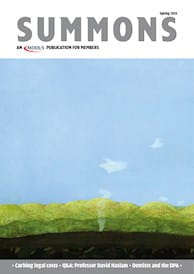FOR most patients, obtaining a prescription is a straightforward and simple matter. Indeed for the most part it is also a simple matter for a practice to produce prescriptions. However, on closer examination, prescribing systems can be highly complex. Taking care not to make accidental errors is repeatedly emphasised but less attention is paid to the risk of abuse of a system – be this by patients or staff. Unfortunately, abuse of prescribing systems is not rare and in some instances such abuse can go on for a significant time before coming to light.
Prescribing a medication can be split into five steps: source, generation, transmission, dispensing and delivery. Prescription requests are generated from a variety of sources including direct requests, from a list of repeats, from hospital letters or during consultations. They come in different forms and may be handwritten or electronic, transmitted by staff, patients or others, and dispensed and delivered by a variety of different methods and individuals. At any one of these stages the system can be abused by staff, other colleagues, patients or anyone acting on their behalf.
When staff members are involved it may be opportunistic, for example when medicines are handed back in by patients and kept for personal use rather than being properly disposed of. In other cases there may be a clear and systematic approach to obtaining prescriptions/medicines by deceit.
Such abuse, once discovered, can have a major impact on a practice. Falsified medication records can result in significant adverse consequences for both patients and professional staff, with regulatory investigation (and possibly suspension or erasure) or even police involvement. Misuse of the system necessitates investigation and review which can be very time consuming and distressing.
Examples of cases handled at MDDUS typically involve:
- lack of a process to properly identify those requesting or picking up a prescription/medication
- staff adding medication to patient records then keeping it
- doctors using medication issued in patient names
- patients/relatives altering a prescription by adding more items.
- Points to consider
In prescribing, as with many practice systems, much depends on goodwill and trust. Imposing strict restrictions and checks may not be practicable – but it is essential to have proper processes in place. Here are some points to consider:
- How are anomalies highlighted?
- Is there robust incident reporting?
- Is there a clear policy regarding SEAs and is this used for prescription incidents?
- What if prescriptions go missing?
- Is there any audit of errors identified by the pharmacy?
- Are prescription pad serial numbers logged?
- Do staff pick up prescriptions for patients? Is there a protocol for this in your prescribing policy?
- Are repeats still issued when review dates are passed?
- Can the computer be overridden? Is this logged with reasons?
- Can repeats be initiated by admin staff? Are there controls in place?
- Do the same controls apply to nurse-generated prescriptions?
Every practice should have a written prescribing policy that is properly implemented and reinforced with adequate staff training at all levels. Any anomalies should be audited and, where appropriate, a significant event review should be undertaken, again to include all staff. In this way policies can be emphasised and reviewed with everyone. Intermittent audits of prescribing trends can be a useful way to monitor prescribing and can pick up unusual patterns.
Health matters
Cases where staff misuse prescribing systems can often trigger complex medico-legal investigations, notably involving the regulator. In many cases the misuse will have continued for considerable periods of time without being picked up. Usually this will be the result of underlying ill health where medication is obtained under false pretences – perhaps first to control symptoms then leading to dependency and addiction. It is worth noting here that if a GMC/GDC investigation is in relation to a health matter solely this cannot result in the erasure of the doctor/dentist.
Practices are always concerned to note the duration of the misuse – and how long they have been unaware. In many cases a controlled prescribing system, involving audit, would have picked up anomalies. Early detection is in everyone’s interest. In summary, consider two questions: if someone is misusing your prescribing system would you know, and can you closely monitor how well it is working?
In any case of doubt MDDUS advisers are happy to offer advice and guidance to our members – be they responsible for the prescribing system or if they find themselves in personal difficulties.
Dr Gail Gilmartin is a senior medical and risk adviser at MDDUS
This page was correct at the time of publication. Any guidance is intended as general guidance for members only. If you are a member and need specific advice relating to your own circumstances, please contact one of our advisers.
Read more from this issue of Insight

Save this article
Save this article to a list of favourite articles which members can access in their account.
Save to library